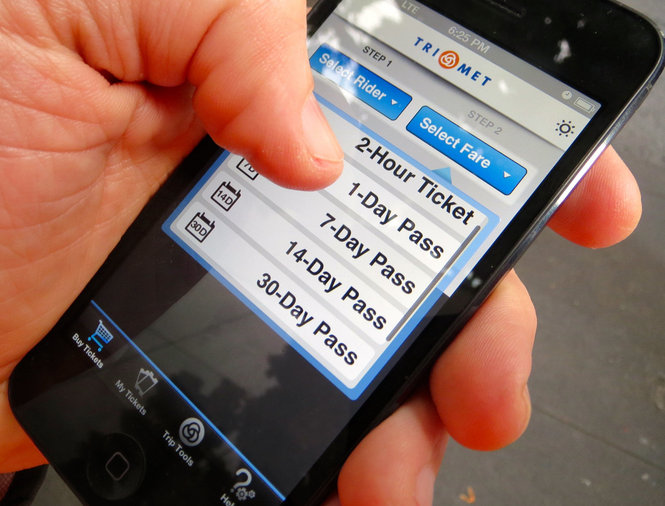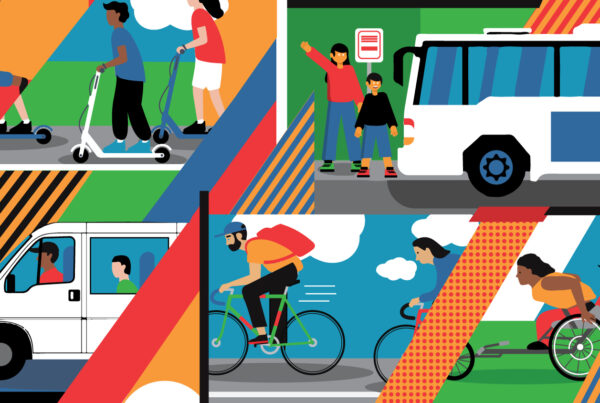By Susan Shaheen, PhD, and Matt Christensen
In the wake of the automobile’s 20th-century boom, the next notable shift in urban transportation may largely be defined by the digitization of mobility, including public transit and shared-vehicle services. With a growing population of multi-modal travelers and the development of shared-use transportation, the demand for seamless access to different modes is rising, particularly as environmental and socio-economic pressures mount. Shared-use mobility facilitates this short-term access to various modes: public transit, carsharing, bikesharing, car- and vanpooling, on-demand ride services (such as Uber, Lyft, and Sidecar), and shuttle services (such as RidePal, Genentech, Google, and Facebook shuttles).
But transitioning from a world chock-full of tickets, memberships, and key fobs to a world where travelers compare modes, plan routes, and pay for publicly accessible services on a single digital platform involves overcoming many barriers. Even the most advanced smartphone apps and other digital platforms that aggregate trip data and services still have major limitations. This vision of urban mobility hinges upon transportation providers — both public and private — sharing data, collaborating, and supporting innovation.
The Importance of Open Data
Central to the development of an intelligent transportation system is open data. To understand and monitor the complete network of available transportation modes, each modal provider must be willing to make their data available to an aggregator. The closer that data is to real time, the better for the system.
While it is widely expected that the public sector will support open data policies, the private sector is generally more hesitant to share data. Many private-sector mobility providers see a competitive advantage in keeping data proprietary. This may be the case in certain situations, but there are many benefits associated with a private company opening its data: these include increasing system efficiency, expanding the market of users, fostering innovation ancillary to the service, and other benefits associated with transparency (e.g., emission and fuel-use reductions).
When those benefits don’t provide enough incentive for private mobility providers to share their data, mandates could offer a solution. In the case of urban mobility, many services require access to public rights-of-way to operate and are subject to the policies imposed by the local governing bodies. Local policies could request that mobility providers share their data in exchange for access to the rights-of-way as one way to foster an open data environment.
Smartphones: The Good and the Bad
A clear way to handle open data and integrate mobility services is through smartphones. Via mobile apps, these powerful tools are capable of aggregating trip data from a variety of mobility providers and presenting it to users in a coherent, organized manner.
One app at the hub of multi-modal integration is RideScout. After users plug in their starting location and select a destination, the app displays a number of different modal options, including estimated travel times and costs. But despite being the most comprehensive app on the market to date, RideScout is still constrained by its inability to plan a single trip that uses multiple modes — known as intermodal or mixed-modal commuting. And with a growing number of individuals relying on public transit and shared-use mobility options to complete a single trip — frequently to address the first/last mile problem — the demand for intermodal trip planning is on the rise.
The smartphone’s limitations go beyond the functionality of the apps they host. First, “points of access” can present a problem for public transit providers. Passengers typically board a bus or a train with a paper ticket or an RFID card. While there are a growing numbers of mobile ticketing success stories for public transportation, retrofitting stations with the ability to accept payments from smartphones is a significant investment for transit agencies.
The smartphone also has its own cost barriers. Of U.S. residents making less than $30,000 per year, less than half own a smartphone. (Conversely, over 78 percent of people earning $75,000 or more own one.) Educational attainment and age show a similar correlation, with older and less educated people less likely to own a smartphone than younger, more educated individuals. While the percentage of smartphone owners will increase in the years ahead within all socio-demographic cohorts, equity will remain a prominent issue without subsidies.
What’s Next in Urban Mobility?
Apart from the smartphone, RFID technology may also play an increasing role in multi-modal and intermodal transportation in the future. Most public transit services, as well as many carsharing and bikesharing providers, currently enable user access through a RFID card. Some partnerships have already been formed; for instance, in 2009, the Chicago Transit Authority and I-Go Carsharing began offering a joint carsharing and public transit pass. In New York, San Francisco, and Chicago, bikesharing systems are equipped with RFID card readers in anticipation of a multi-use RFID card. And in London, the Oyster card has set the precedent for RFID admission, as cardholders are able to access local and regional forms of the transportation network with a single card, including the subway, light rail, regional rail, trolleys, and buses.
The future of urban mobility is certainly not predetermined. Changes to how cities move people and goods will depend on the technology and the market — as well as the people powering both. Based on our understanding of the current practice and trends, however, we expect that the number of multi-modal and intermodal travelers will continue to expand. Where smartphones aren’t affordable or otherwise desired, other digital platforms, including publicly accessible kiosks, will meet the needs of city travelers. And where a gap exists in the transportation network, innovative mobility service providers can help to fill those spaces.
Photo credit: Portland Trimet Transit App


